Howdy Doody / Howdy Doody for President (original) (raw)
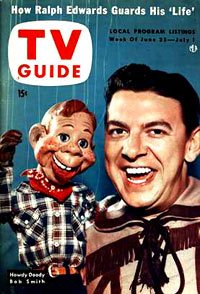
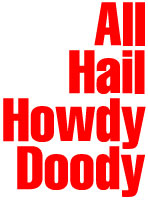
by L. Wayne Hicks PART TWO (READ HOWDY DOODY PART ONE HERE)
Howdy Doody announced his campaign on the 11th show, which aired March 4, 1948. The campaign tied in with a concern of NBC's; in those early days of television, the network wanted some way to measure the viewing audience. Roger Muir, the show's original producer-director, thought of offering a button that said "I'm for Howdy Doody" to anyone who wrote in and requested one. He ordered 10,000 buttons.
Even in the beginning, whatever Howdy wanted, Howdy got. He wanted children to write in supporting his campaign? He got it. The requests for I'm for Howdy Doody buttons kept coming in. Two days after the button offer was announced, NBC issued a press release that 6,304 requests have been received. A day later, that figure was revised to 26,000.
Smith told People magazine in 1989: "The response was overwhelming, like 150,000 returns after one mention on the air, and we had only ordered 10,000 buttons. We had no idea it would be that successful, but it turned out everybody was over at the neighbor's house watching The Howdy Doody Show."
Smith estimated that more than 250,000 kids wrote in asking for the button.
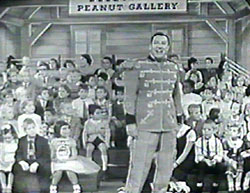 Based on the response to the button give-away, sponsors lined up to buy air time on Howdy Doody. Colgate was an early supporter of the show. So was Kellogg's. Toy makers took notice of Howdy's appeal. Requests came in to manufacture Howdy Doody dolls. Paris, who'd been paid $500 to make the marionette, wanted a cut of any sales of Howdy Doody merchandise. NBC balked at that idea; Paris packed up Howdy and went home, leaving the show without its star.
Based on the response to the button give-away, sponsors lined up to buy air time on Howdy Doody. Colgate was an early supporter of the show. So was Kellogg's. Toy makers took notice of Howdy's appeal. Requests came in to manufacture Howdy Doody dolls. Paris, who'd been paid $500 to make the marionette, wanted a cut of any sales of Howdy Doody merchandise. NBC balked at that idea; Paris packed up Howdy and went home, leaving the show without its star.
Fortunately, the campaign storyline Kean already had begun served to explain Howdy's sudden absence from the set. Kean sent Howdy off on the campaign trail, starting in Portland, Oregon.
"We picked the farthest place we could," Smith once said, "and explained that he had met his handsome rival Mr. X and realized he wouldn't get any votes from girls unless he had plastic surgery."
During the marionette's absence from the show, Howdy was heard over a loudspeaker, called the Super Talk-O-Scope on the show.
That wasn't enough to satisfy the sponsors, who wanted Howdy on camera pushing their products, Smith wrote in his autobiography, "Howdy and Me."
"I prerecorded his voice each day, then spoke to him on the air on the Super Talk-O-Scope," Smith wrote. "He'd tell us about the hospital, and how he was fine, didn't mind plastic surgery, and knew he'd get the girls' votes now that he'd be handsome too. In other words, we stalled and stalled.
"This appeased the kids, but not the sponsors. They wanted Howdy in the commercials and not just on the Super Talk-O-Scope. Eddie Kean rose to the challenge again, suggesting that we find any puppet, dress him appropriately, and bandage his head. The puppet appeared on the air, assuring the boys and girls of his excellent health and the advisability of brushing with Colgate's or whatever."
The bandages finally came off June 8, 1948, revealing the red-headed, freckle-faced boy that became so familiar.
Sponsors began to join in Howdy's campaign efforts. Children were invited to vote by filling out a form printed on the end of Wonder Bread bags. Post Cereals included a Howdy Doody for president ring.
Like any good politician, Howdy told the children what they wanted to hear, promising two Christmas holidays but just one school day a year and more pictures in history books. Time magazine even took note of the campaign, reporting that Howdy was pushing for free admission to the circus and rodeo.
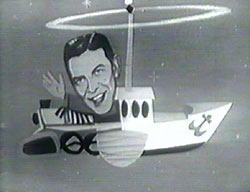 Kean wrote a simple, but effective, campaign song for Howdy Doody that Buffalo Bob sang:
Kean wrote a simple, but effective, campaign song for Howdy Doody that Buffalo Bob sang:
Howdy Doody, for president,
He's America's choice.
Howdy Doody for president,
the favorite of all the girls and boys.
Howdy Doody for president,
He's the fellow for me.
Howdy Doody for president,
Let's sweep him on to victory.
He also penned another campaign song as well, which Buffalo Bob sang and the peanut gallery shouted their answer:
BUFFALO BOB: I'm for Howdy Doody, are you?
PEANUT GALLERY: Yes, I am!
BUFFALO BOB: I'm for Howdy Doody, so let's all give him a hand.
I'm for Howdy Doody, are you?
PEANUT GALLERY: Yes, I am!
BUFFALO BOB: I'm for Howdy Doody, the finest boy in the land.
You can look all night,
look all day,
look from Maine to Californ-eye-ay,
ask each boy and girl you see,
you will find they all agree that they're for Howdy Doody.
Are you?
PEANUT GALLERY: Yes, I am!
Kean wound up writing 99 songs and 1,980 scripts during his tenure on the show. "For seven years, I never took a rest," he told Jeff Kisseloff in the book "The Box: An Oral History of Television." "When I went on vacation, I took a typewriter and mailed my scripts to New York. I wrote every word for seven years, and after that I had had enough."
Kean, who was just 23 when he started with Buffalo Bob, went on to write for other TV shows, commercial jingles, sell stock on Wall Street and work in public relations and advertising. Today he plays the piano in a hotel bar.
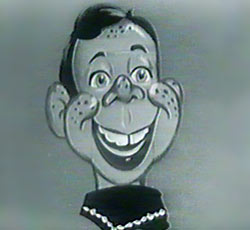 He recalled in Stephen Davis' book, "Say Kids! What Time Is It?" that the nine-month campaign offered a chance to educate children about the various states Howdy visited. "We talked about making cheese in Wisconsin and coal mines in Pennsylvania. We tried to educate the kids and show them what this country was all about. We were all proud we got all the four- and five-year-olds acquainted with the names of the states."
He recalled in Stephen Davis' book, "Say Kids! What Time Is It?" that the nine-month campaign offered a chance to educate children about the various states Howdy visited. "We talked about making cheese in Wisconsin and coal mines in Pennsylvania. We tried to educate the kids and show them what this country was all about. We were all proud we got all the four- and five-year-olds acquainted with the names of the states."
The campaign gave Kean the chance to figure out just who the mysterious Mr. X would be. He didn't have a clue. But to keep the mystery going, kids in the peanut gallery were invited to guess what Mr. X might look like. All the children really knew about Mr. X was that, as Buffalo Bob described him, "the handsomest man in the world," and he was opposed to everything Howdy stood for. Mr. X campaigned that school should be seven days a week, that no child should ever get an ice cream sundae and that comic books should be banned.
"His campaign was all negatives," Kean recalled in an interview conducted via e-mail. "No ice cream, no movies, more homework. No one could understand why or how he expected to win that way."
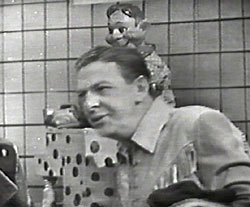 Kean decided who Mr. X was only after seeing the new Howdy Doody, unbandaged at last. He would make Mr. X Howdy's twin brother, Double Doody. The twin was a second marionette created to allow Howdy to make costume changes. The negative campaign run by Mr. X suddenly became clear.
Kean decided who Mr. X was only after seeing the new Howdy Doody, unbandaged at last. He would make Mr. X Howdy's twin brother, Double Doody. The twin was a second marionette created to allow Howdy to make costume changes. The negative campaign run by Mr. X suddenly became clear.
"His awful campaign was to ensure the victory of his brother Howdy and keep other potential candidates out of the picture," Kean said.
No less than The New York Times paid attention to Howdy's victory. TV columnist Jack Gould reported that Howdy beat Mr. X by "a margin of 10,000,000 ballots, more or less." Gould wrote that Howdy finished third in the overall presidential race, behind Harry Truman and Thomas Dewey, but racked up 10 times the votes afforded Henry Wallace. Kean's recollection is that Howdy received more than 25 million votes while Mr. X got one.
All of those numbers are probably greatly inflated; on a show the week before the election, the Votedoodle reported that so far Mr. X had attracted 64,129 votes while Howdy had received 406,620.
No matter. Howdy couldn't lose the election. With Kean in control, the fix was in. Howdy was inagurated Jan. 14, 1949, as "President of all the Kids in the United States." He was sworn in by Ben Grauer, announcer for the NBC Symphony Orchestra.
Other election campaigns would follow. Howdy ran for re-election in 1952, and again won by an overwhelming majority to continue as President of All the Kids. A full 30 years later, long after Howdy's show had left the air, the marionette attempted a political comeback, running in the 1972 race. His platform supported subsidies for Santa Claus, the Easter Bunny and the Tooth Fairy. He surfaced again as a candidate in 2000, this time stumping to make spaghetti the national food.
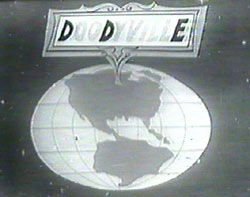 The 2000 race, conducted online between a company that held the licenses to market Howdy Doody and Gumby, pitted the two against each other. The final votes were never tallied, but Gumby - more familiar to today's generation - took a clear lead in the early voting.
The 2000 race, conducted online between a company that held the licenses to market Howdy Doody and Gumby, pitted the two against each other. The final votes were never tallied, but Gumby - more familiar to today's generation - took a clear lead in the early voting.
HOWDY DOODY READ PART ONE HERE